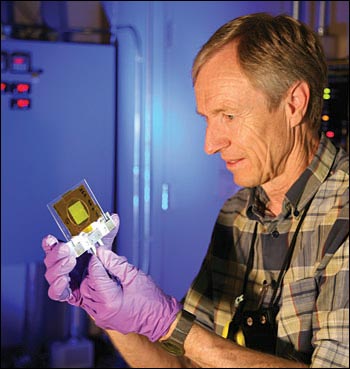Researchers at Los Alamos National Laboratory are conducting a novel medical isotope project that will help produce at a rapid rate, significant quantities of actinium 225 (Ac-225), which is a newly discovered agent for treating cancer.
 Los Alamos scientist Meiring Nortier holds a thorium foil test target for the proof-of-concept production experiments.
Los Alamos scientist Meiring Nortier holds a thorium foil test target for the proof-of-concept production experiments.
Brookhaven National Laboratory and Los Alamos were able to match present annual global production of Ac-225, in a very short span of a few days using proton beams, thus overcoming the challenge of critical shortages of this cancer treatment agent.
Los Alamos, Oak Ridge and Brookhaven national laboratories are formulating a plan for stable supply and full-scale production of Ac-225.
Alpha radiation is emitted by Ac-225. These particles have sufficient energy to destroy cancer cells but they cannot move beyond a specific target region and kill healthy cells. Either an inch or two of air or a layer of skin can stop Alpha particles in their tracks.
Isotope Cancer Treatment Research at LANL
It must be noted that the present need for Ac-225 is more than the supply possible by conventional production methods. The isotope group of the Nuclear Science Advisory Committee pointed out the gap between demand and supply and stated that the US must invest in novel production approaches for alpha emitters with a significant priority for Ac-225.
This particular research work helps address this need. The Los Alamos Neutron Science Center (LANSCE) has a specialized particle accelerator where production of Ac-225 takes place by the irradiation of thorium target foils. A 100 MeV proton beam and a 200 to 800 MeV supplied to the Lab’s Isotope Production Facility and the LANL’s Weapons Neutron Research Facility, respectively were used by the scientists.
This Ac-225 effort is now endeavoring to develop bulk-scale radiochemical processing and high-power targetry in order to offer this material as a medical isotope that is routinely available.
The funding of the project was done by the U.S. Department of Energy Office of Science through a grant from the Office of Nuclear Physics, Isotope Development and Production for Research and Applications.